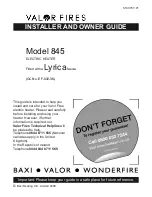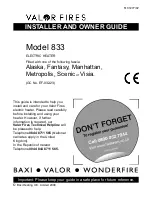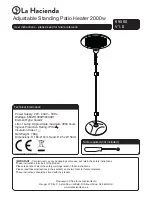
This water heater is certified for installations
up to 3,280 feet (1000 m) above sea level.
The input rating of this water heater is based
on sea level operation. At higher elevations,
the actual input rate may be lower than the
value listed on the rating label.
NOTICE: For installations above 3,280
feet (1,000 m) elevation, contact a quaili-
fied service technician to make the proper
altitude adjustment. See page 35 for ad-
ditional information.
Do not install this water heater at eleva-
tions above 3,280 feet (1,000 m) without
the proper adjustement. Please contact
your installer, local gas supplier, place of
purchase or the Customer Service phone
number as listed in this Use & Care Manu-
al for more information.
High Altitude
Installing the Main Remote Control:
WARNING: Do not attempt to convert this water heater for use with a different type of gas other than the type shown
on the rating plate. Such conversion could result in hazardous operating conditions.
Gas Supply
The supplied Manual Gas Appliance Shutoff
Valve must be installed at the gas connection of
the water heater at the time of installation (see
diagram to the left).
The branch gas supply line to the water heater
should be a minimum of 3/4” black steel pipe
or other approved gas piping material.
A ground joint union or ANSI design certified
semi-rigid or flexible gas appliance connector
should be installed in the gas line close to the
water heater. The National Fuel Gas Code
(NFGC) ANSI Z223.1 and CAN B149 code
mandates a manual gas shut-off valve: See
NFGC & B149 for complete instructions.
If flexible connectors are used, the maximum
length shall not exceed 36” (91 cm).
If lever type gas shut offs are used, they shall
be approved / certified gas cocks.
Compound used on the threaded joints of the
gas piping must be of the type resistant to the
action of LP gas. Use compound sparingly on
male threads only.
A sediment trap should be installed at the
bottom of the gas line.
Do not use excessive force (over 31.5 ft lbs.
[42.7 Nm]) in tightening the pipe, particularly if
teflon pipe compound is used, as the unit may
be damaged.
The inlet gas pressure to the water heater must
not exceed 10.5” w.c. (2.6 kPa) for natural or
14” w.c. (3.5 kPa) for LP gas. For purposes
of input adjustment, the minimum inlet gas
pressure (with main burner on) is shown on
the water heater rating plate. If high or low gas
pressures are present, contact your gas supplier
for correction.
NOTICE:
To ensure proper operation of the
heater the gas pipe and gas meter must be sized
correctly.
Gas piping shall be in accordance with local,
utility company requirement and/or in the
absence of local codes, use the latest edition of
the National Fuel Gas Code. In Canada, the latest
edition of CSA B149.1 Natural Gas and Propane
installation code.
Manual
Gas
Supply
Line
Shutoff
Manual Gas
Appliance
Shutoff
Union
Sediment Trap
Cap
(Valve)
(Supplied)
Leak Testing
The water heater and its gas connections must
be leak tested at normal operating pressures
before it is placed in operation.
Turn on the gas shut-off valve(s) to the
water heater.
Use a soapy water solution to test for
leaks at all connections and fittings.
Bubbles indicate a gas leak that must
be corrected.
The factory connections should also be leak
tested after the water heater is placed in
operation.
WARNING: Never use
an open flame to test for
gas leaks, as property
damage, personal injury,
or death could result.
Pressure Testing the Gas Supply System
The water heater and its manual gas shut-
off valve must be disconnected from the gas
supply piping system during any pressure
testing of the system at pressures in excess
of 1/2 psi (14” w.c. [3.5 kPa]).
The water heater must be isolated from the
gas piping system by closing the manual gas
shut-off valve during any pressure testing of
the gas supply piping at pressures equal to or
less than 1/2 psi (14” w.c. [3.5 kPa]).
WARNING: Install a gas
pressure regulator, in the
gas supply line, which does
not exceed the maximum
supply pressure.
DO NOT use an industrial
type gas regulator.
18
















































